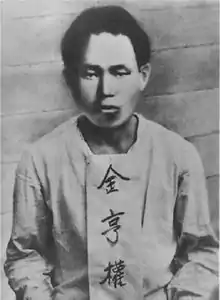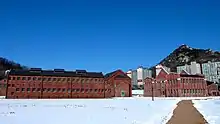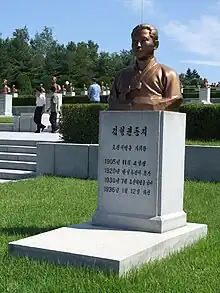Kim Hyong-gwon
Kim Hyong-gwon (Korean: 김형권; 4 November 1905 – 12 January 1936) was a Korean revolutionary. He is known for attacking a Japanese police station in Japanese-occupied Korea and subsequently dying in Seoul's Seodaemun Prison where he was serving his sentence.
Kim Hyong-gwon | |
|---|---|
김형권 | |
 Kim Hyong-gwon in prison with a name tag | |
| Born | 4 November 1905 |
| Died | 12 January 1936 (aged 30) (in captivity) |
| Nationality | Korean |
| Occupation | Guerrilla |
| Organization | Young Communist League of Korea[2] |
| Parent(s) | Kim Bo-hyon (father) Lee Bo-ik (mother) |
| Relatives | Kim dynasty |
| Korean name | |
| Chosŏn'gŭl | |
| Hancha | |
| Revised Romanization | Gim Hyeonggwon |
| McCune–Reischauer | Kim Hyŏnggwŏn[3] |
Kim Hyong-gwon was an uncle of the founding North Korean leader, Kim Il Sung.[2] As such, he is among the most celebrated of the Kim family members in North Korean propaganda. Kimhyonggwon County in North Korea is named after him.
Personal life

In his youth, Kim Hyong-gwon studied in Sunhwa school near his home in present-day Mangyongdae, Pyongyang.[4]
Kim was a revolutionary fighter and an active communist in the 1930s. His personality has been described as "hot-tempered".[5] In August 1930, he led a small detachment of guerrillas across the Amnok (Yalu) river to Japanese-occupied Korea from Manchuria.[2] His small group's actions near Pungsan at that time got noticed by the Japanese press.[6] He captured two Japanese police cars, and both of these acts occurred in mountainous terrain.[7][8] Some time after attacking a Japanese police station in Pungsan, he was arrested near Hongwon.[7] He was sentenced to 15 years in prison when he was 28 years old. He died on 12 January 1936, during his sentence in Seoul's Seodaemun Prison,[9][10][11] where anti-Japanese dissidents were detained from 1910 to 1945 in cruel conditions.[12]
Kim Il Sung remarks in his autobiography With the Century, that it was a corrupt yet close Manchurian local official, Chae Jin-yong, who betrayed his uncle and became an informer against him.[10]
Legacy

Kim Hyong-gwon is among the most important Kim family members in propaganda, and comparable in that context to other prominent family members like Kim Il Sung's father Kim Hyong-jik, or great grandfather Kim Ung-u, who is claimed to have been involved in the General Sherman incident.[3][13] North Korean propaganda insists that most family members were in some way participating in the foundation of the North Korean state and among them Kim Hyong-gwon is portrayed as having been sacrificed for anti-Japanese struggle and the revolution.[3]
Kim Hyong-gwon was included into the personality cult in 1976.[14] North Korean media uses similar honorifics for him as they use with Kim Il Sung, Kim Jong Il, Kim Jong Un and Kim Jong-suk.[15]
Kimhyonggwon County, previously known as Pungsan, in southeastern Ryanggang Province, was renamed after him in August 1990.[16] There is also a Kim Hyong Gwon Teachers' College named after him, and Hamnam University of Education Nr. 1 was renamed Kim Hyong Gwon University of Education in 1990. Both of them are in Sinpo.[17] Various sites of honor and statues have been made in Kim's memory. Once every five years, a ceremony is held on the days of his death and birth.[3]
A North Korean film A Fire Burning All Over the World was made in 1977. It deals with both Kang Pan-sok and Kim Hyong-gwon's revolutionary deeds. The film was also the first one to portray Kim Il Sung.[3]
In 2010, South Korea awarded Kim Hyong-gwon the Patriotic Medal, 4th grade of the Order of Merit for National Foundation, for his role in the independence movement apparently without knowing that he was a relative of Kim Il Sung.[18]
See also
References
- An Indomitable Revolutionary Fighter — Comrade Kim Hyong Gwon 1976, p. [29].
- An Indomitable Revolutionary Fighter — Comrade Kim Hyong Gwon 1976, p. [5].
- Jae-Cheon Lim (24 March 2015). Leader Symbols and Personality Cult in North Korea: The Leader State. Taylor & Francis. ISBN 978-1-317-56740-0.
- An Indomitable Revolutionary Fighter — Comrade Kim Hyong Gwon 1976, p. [7].
- Bradley K. Martin (1 April 2007). Under the Loving Care of the Fatherly Leader: North Korea and the Kim Dynasty. St. Martin's Press. p. 191. ISBN 978-1-4299-0699-9.
- An Indomitable Revolutionary Fighter — Comrade Kim Hyong Gwon 1976, p. [14].
- An Indomitable Revolutionary Fighter — Comrade Kim Hyong Gwon 1976, p. [12].
- An Indomitable Revolutionary Fighter — Comrade Kim Hyong Gwon 1976, pp. [18–19].
- An Indomitable Revolutionary Fighter — Comrade Kim Hyong Gwon 1976, p. [5], [29].
- Cathcart, Adam (14 January 2012). "Historical Allegories and Revolutionary Credentials: Jang Song Taek". Sino-NK. Retrieved 11 July 2015.
- "Kim Il Sung's Life to the Korean War". KoreanHistory.info. Retrieved 11 July 2015.
- "Seodaemun Prison". Lonely Planet. Retrieved 11 July 2015.
- Whyte, Leon (21 March 2014). "Anti-Americanism in South Korea: Why one of our closest allies has mixed feelings". smallcrowdedworld.com. Archived from the original on 13 July 2015. Retrieved 11 July 2015.
- Jae-Cheon Lim (September 2010). "Institutionalization of the cult of the Kims: its implications for North Korean political succession". ResearchGate. Retrieved 11 July 2015. North Korean media uses similar honorifics for him as they use with Kim Il-sung, Kim Jong Il, Kim Jong Un and Kim Jong-suk.
- "NK Media Using Honorific Language on Heir Apparent". The Dong-a Ilbo. 5 November 2010. Retrieved 11 July 2015.
- Yonhap News Agency, Seoul (27 December 2002). North Korea Handbook. M.E. Sharpe. p. 47. ISBN 978-0-7656-3523-5.
- Dormels, Rainer (2014). "Profiles of the cities of DPR Korea – Sinpho" (PDF). University of Vienna. Retrieved 11 July 2015.
- 박희석 (August 2016). 북한 김일성 일가 우상화에 ‘동조’한 박승춘 보훈처. Monthly Chosun (in Korean). Retrieved 14 February 2021.
Sources
- An Indomitable Revolutionary Fighter — Comrade Kim Hyong Gwon. Pyongyang: Foreign Languages Publishing House. 1976. OCLC 3526301.
Further reading
- Kim Il-sung (1994). With the Century. Vol. 1–2. Pyongyang: Foreign Languages Publishing House. OCLC 28377167 Volume 1 chapters 1–3, and volume 2 chapters 4–5.
{{cite book}}: CS1 maint: postscript (link)